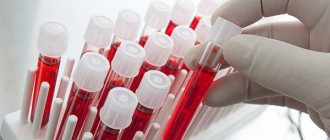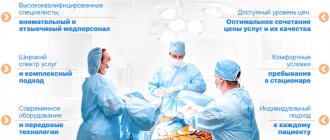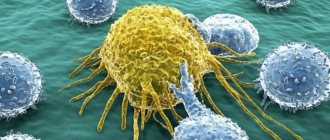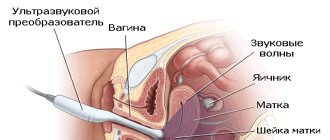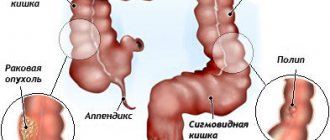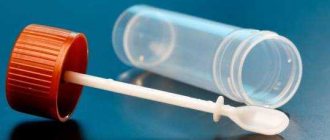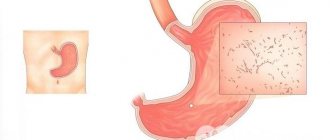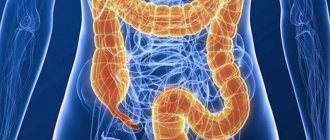Sigmoidoscopy belongs to a group of endoscopic procedures for which a special device is used - an endoscope, called in this case a rectoscope. The device looks like a simple tube, usually made of metal and hollow inside, of small diameter, which is equipped with optics. The examination is carried out when the device is inserted into the rectum.
During the procedure, an endoscopist, or sometimes a proctologist, has the opportunity to examine the condition of the intestinal mucosa, capturing a small section of the sigmoid (the length is about 30 cm from the anus) and, if necessary, pinch off part of the detected tumor for subsequent histological analysis.
The essence and goals of the diagnostic method
Sigmoidoscopy is one of the methods for diagnosing the lower intestine, in which the doctor examines the inner surface of the tissue. This technique is characterized by high accuracy of the results obtained, therefore it is considered a mandatory procedure for all proctological diagnostics. Thanks to sigmoidoscopy, doctors are able to obtain data on the condition of the distal sigmoid and rectum. The area up to 30 cm from the anus is examined.
Proctologists note that patients over 40 years of age are recommended to undergo a rectoscopy procedure once a year. This will allow timely detection of the process of development of neoplasms in the intestines. Including small tumors that are inaccessible for diagnosis by other methods.
Purposes of sigmoidoscopy. Filmed by Daria Panaioti channel.
What can sigmoidoscopy show?
The purpose of the examination is to timely detect the source of inflammation and signs of the spread of intestinal infection. During the examination, hemorrhoidal “clusters”, hypertrophic anal papillae can be detected, polyps, the presence of anal fistulas and fissures can be confirmed.
Normal picture
Upon examination, the proctologist notes an orange-pink coloring of the mucous membrane of the visible part of the sigmoid colon, the formation of pronounced crescent-shaped folds and tubular-like hollows. The rectal mucosa has a bright red, almost crimson color (there is a very dense network of blood vessels here), and in the area of the rectal-anal line the intestinal walls become completely “cherry.” There are 3 dampers formed in this area. The lower 2/3 of the anal canal is covered with anoderm (grayish-brown, without roughness), which passes into the epidermis of the anal region.
Possible deviations
As a result of examination with an endoscope and subsequent palpation of the anus and accessible area of the rectum, a variety of diseases and pathologies can be identified. During the procedure, biomaterial is also taken for cytological, microbiological and histological studies.
However, there are a number of factors that influence the result of the inspection, and therefore they should definitely be taken into account:
- fecal matter makes it difficult to insert the endoscope and makes the examination almost impossible;
- residual barium significantly complicates the examination (remains, as a rule, after an X-ray contrast examination);
- violation of the conservation of biological material taken from the patient and untimely delivery to the laboratory for appropriate tests.
Indications and contraindications
Main indications for sigmoidoscopy:
- Constipation. If problems with the toilet are chronic, constipation is present, or vice versa, the stool is too liquid, you should pay attention to the functioning of the intestines and carry out the procedure.
- Pain and itching. If there is pain or discomfort in the anus, perineum or lower left abdomen, look for the cause of the disease using sigmoidoscopy.
- Rectal prolapse. Among the first indications for diagnosis is rectal prolapse during defecation.
- Uncharacteristic impurities in feces. If you notice any discharge of pus, mucus or bleeding in your stool, you should immediately consult a doctor.
- Carrying out operations. For ovarian cysts, patients are recommended to undergo an RRS sigmoidoscopy examination.
A timely sigmoidoscopy allows you to exclude the following diseases:
- chronic inflammation (sigmoiditis, proctitis);
- pathologies of the rectum (hemorrhoids, anal fissures, polyps, fistulas);
- oncological neoplasms of the lower intestine, benign or malignant;
- nonspecific ulcerative colitis.
Despite the fact that the sigmoidoscopy procedure is not a complex procedure and does not cause pain to the patient, there are a number of contraindications to the study. In this case, the patient must undergo a course of treatment and seek re-diagnosis.
Sigmoidoscopy is contraindicated in the following cases:
- if the patient has acute anal fissures;
- for acute inflammation of the abdominal cavity (peritonitis);
- when there is a narrowing of the intestinal lumen;
- if the patient suffers from acute paraproctitis;
- with heavy blood loss from the rectum;
- when the patient has signs of pulmonary or heart failure;
- for mental disorders that do not allow the patient to calmly endure the diagnostic procedure;
- in case of general serious condition.
A contraindicated factor for intestinal examination is pregnancy.
Indications for use
The procedure is indicated for:
bleeding of varying intensity from the anus , which may indicate a wide variety of intestinal pathologies: from hemorrhoids (internal and/or external) and anal fissures to the formation of polyps and even colon cancer. Such an examination will help clarify the diagnosis and differentiate diseases with similar symptoms. massive discharge of mucous or purulent nature from the anus is a defining sign of proctitis.
severe pain, constantly present or appearing periodically, in the anus . It may be a manifestation of hemorrhoids (internal), intestinal cancer (mainly rectum), and therefore it is necessary to carry out differential diagnosis, one of the “tools” of which is sigmoidoscopy.
According to the recommendations of the World Health Organization (WHO), sigmoidoscopy should also be performed on people over 40 years of age, even without relevant complaints. This is due to the constant increase in the number of cases of rectal cancer detected at stages 3 and 4. In this regard, sigmoidoscopy can be recommended for annual preventive examinations, which will make it possible to detect oncopathologies at early, still practically asymptomatic stages.
Recommendations for preparing for the examination
Preparation for sigmoidoscopy takes only a couple of days; the recommendations do not require much effort from the patient. The doctor explains all the main points to the patient during the consultation.
Necessary actions before the manipulation:
- Purgation. The study is done only after preliminary hygiene procedures. This is done in order to prevent awkward situations for the patient, which will also prevent the doctor from seeing the overall picture of the intestines. If the patient has irregular bowel movements, you can consult a doctor about taking laxatives. Such medications are available in the form of syrups, powders, and tablets. You should do an enema the night before.
- Diet. A couple of days before diagnosis, it is necessary to avoid foods that increase gas formation and enhance intestinal motility. During this period, it is better to limit yourself to baked goods, sweets, legumes and sparkling water. The day before the operation, you should not overeat in the evening; you are allowed to drink a glass of tomato juice and eat a hard-boiled egg.
- Water mode. It is important that preventive enemas and other bowel cleanses not disturb the body’s water balance. To do this, drink enough water at room temperature for the patient’s weight.
- Medicines. A few minutes before the examination, the patient is shown medications that relieve muscle spasms (“Atropine” in the form of injections).
Preparing the patient for the study
The specificity of the procedure explains the presence of special preparation requirements. The patient begins to follow all the rules prescribed by the doctor two days before the appointed date. The whole point of preparation comes down to clearing the examined intestines of feces, since they interfere with the examination. To do this, the doctor prescribes a special slag-free diet to the subject. All foods consumed should be easily digestible and should not contain coarse dietary fiber. 2-3 days before the procedure date you need to exclude from the menu:
- potatoes, pasta and pearl barley;
- fatty fish and meats;
- legumes;
- brown bread, sweet confectionery;
- chocolate;
- nuts;
- seasonings, herbs, spices;
- coffee, strong tea, alcohol, carbonated drinks, kvass, concentrated juices;
- whole milk products.
As part of preparing the patient for examination, the diet should consist of lean fish and meat, boiled or steamed, vegetable decoctions and broths, low-fat fermented milk products, weak green or herbal tea, and clear juices. All physical activity should be kept to a minimum at this time.
An approximate diet before sigmoidoscopy looks like this: two to three days before the procedure, you are allowed to eat buckwheat or oatmeal with water, white bread toast with low-fat cheese, and a glass of tea for breakfast. An hour and a half before lunch, the patient drinks a glass of low-fat kefir. For lunch, you can prepare a weak broth from lean meat, a few meatballs from veal or turkey, or bake lean fish and eat it with a small portion of boiled rice, washed down with a glass of clarified apple juice. A low-fat cottage cheese casserole or a glass of low-fat yogurt is allowed as an afternoon snack. Dinner should be very light - semolina porridge with water or a few biscuits with a glass of fermented baked milk will do.
On the day immediately before sigmoidoscopy, it is necessary to prepare the intestines with the lightest possible meal: for breakfast, 1 soft-boiled egg, toast from white bread with low-fat cheese, a glass of tea is offered, for lunch you can eat a portion of weak meat broth and several pieces of biscuits, washed down with compote or tea. You can no longer have dinner on this day. Before nightfall, you need to prepare to cleanse your intestines of feces.
There are two cleaning methods:
- mechanical;
- medicinal.
For the first one, you can use Esmarch's mug. Rinsing should be done the night before and in the morning immediately before the procedure. Two hours before the enema, you should take 150 milliliters of sour sulfur magnesia or several tablespoons of castor oil.
During the procedure, the person lies on his left side with his legs bent at the knees. For the process you will need one and a half liters of boiled clean water at room temperature. The mug is suspended at a certain height, air is released from the hose, and the tip is inserted into the anus. The water pressure is regulated by a special tap on the hose. To prevent air from entering, there should be some water left in Esmarch's mug. The entire injected volume of liquid must be retained for 7-10 minutes.
If preparation is successful, a clear liquid comes out after rinsing. The method is prohibited for hemorrhoids, ulcers and cracks.
Medicinal cleansing methods make it possible to gently cleanse the intestines at home without disturbing the microflora of the organ. You can take any of the medications you choose:
- Fortrans;
- Flit-phospho-soda;
- Lavacol;
- Microlax;
- Duphalac.
Before taking any of the medications, you should consult with the doctor who will conduct the examination, since the medications have specific uses and contraindications.
Technique and features of the study
The procedure is performed on patients mainly in the morning on an empty stomach. Sigmoidoscopy is permissible only after the doctor, using a digital examination, is convinced that there are no contraindications.
In the process of studying the intestinal walls, the doctor pays attention to the general condition; sigmoidoscopy shows:
- fabric color;
- surface relief;
- vascular pattern;
- tone.
Diagnostics is carried out in the following stages:
- The patient is placed on the couch in the fetal position or in the knee-elbow position (depending on the patient’s personal preferences).
- Next, the doctor lubricates the tube of the device with Vaseline and gradually inserts the tube into the anus to a depth of 5 cm. After this, the patient needs to push a little to allow the tube to penetrate inside without any problems.
- The specialist removes the obturbator and installs an optical eyepiece, which will make it possible to visualize the internal walls of the intestine. At this moment, air is additionally pumped in to straighten the folds and so that the proctoscope can easily fit into the intestinal lumen.
- If during the procedure remains of feces or other secretions are detected, the tube is removed, the intestines are cleaned or excess secretions are pumped out. And also if there is a need to remove visible polyps during the diagnostic process, an electrocoagulator with a loop is used for these actions.
- Particles of detected formations are sent for biopsy to determine the benignity of the tissue.
Sigmoidoscopy of the intestine takes only 5-7 minutes.
Similar diagnostics are also often prescribed for children. The procedure is carried out in the presence of parents; the baby is not hurt during the examination, but the child may be scared. Therefore, it is important to calm him down in order to prevent hysteria, which could interfere with the sigmoidoscopy or lead to injury in the process. The difference in the procedure for very young patients is that they are examined under anesthesia in the supine position.
How is sigmoidoscopy performed?
Before starting an examination of the intestines, the doctor conducts a survey of the patient and a mandatory digital examination of the rectum. The technique of the procedure is explained to the patient, and they are warned about the possible appearance of the urge to have a bowel movement, as well as various uncomfortable sensations. Unpleasant manifestations appear due to the supply of air into the intestine. Spastic contractions may also occur. All that is required of the person being examined at these moments is to breathe slowly and deeply and focus on breathing. The doctor talks about all this before the examination begins.
The patient undresses below the waist and takes the appropriate position on the examination table - knee-elbow, or lying on the left side with legs bent at the knees. Doctors say that the first option is more preferable, since in this case the endoscope passes more easily from the rectum to the sigmoid colon.
The tube of the device is lubricated with Vaseline, after which the doctor inserts it into the anus 4-5 centimeters deep. After this, the examinee needs to strain, as if defecating - at this moment the diagnostician inserts the tube even deeper. The obturator covering the distal end of the tube is removed, and special optics are inserted into the device. With its help, the doctor conducts a visual examination of the mucous membranes, gradually moving the tube forward or backward, and also carefully tilting it so as not to injure the intestinal walls. In this case, air is gradually pumped into the intestine through the tube - this allows the folds of the intestine to be straightened.
If the bowel cleansing is not carried out thoroughly enough, and the view is hampered by the remains of the intestinal contents, the device is removed, the excess is removed with a sterile swab, after which the procedure begins again. If there is blood, pus, or mucus in the intestine, they are pumped out with a special electric suction. The doctor removes polyps by inserting a special coagulation loop into the intestine through the tube of the device. It cuts off the tumor, after which it is removed from the intestine and sent for histological examination. Such manipulations can be carried out with pain relief. The patient is given local anesthesia, after which the removal of the formation begins.
Best materials of the month
- Why you can't go on a diet on your own
- 21 tips on how to avoid buying stale food
- How to keep vegetables and fruits fresh: simple tricks
- How to curb your sweet cravings: 7 unexpected products
- Scientists say youth can be extended
After the visual examination and all invasive measures are completed, the device is slowly removed from the intestine.
Examination procedure for children and pregnant women
The requirements for preparing a child for sigmoidoscopy are identical to the algorithm for preparing adults. A diagnostic examination of the rectum and sigmoid colon for children of primary school age is carried out under general anesthesia. Sigmoidoscopes intended for small patients are smaller in size. In case of narrowing of the anus, peritonitis and inflammatory changes in the anus, the procedure is not prescribed.
Sigmoidoscopy in pregnant women is allowed only during the first trimester if it is approved by a gynecologist, endoscopist and gastroenterologist. Together, these specialists decide whether the benefit of the examination for the mother outweighs the level of potential threat to the fetus, and how appropriate it is in a particular case.
results
Immediately after completion of the examination, the doctor gives the patient preliminary test results. The biopsy data will be known a few days after the material has been studied by specialists. After this, the patient must seek a second consultation with the primary doctor.
Among the main options for diagnostic results are:
- a condition characteristic of hemorrhoids;
- intestinal polyp or tumor neoplasms;
- ulcerative colitis;
- surface with a clearly cut out vascular pattern.
The accuracy of the results may also be affected by:
- the presence of fecal deposits in the sigmoid or rectum;
- conducting an X-ray examination of the rectum, when a contrast agent (barium solution) is injected into the cavity;
- the patient has signs of severe diverculitis;
- recent surgical interventions on the intestines.
Protocol (form) for sigmoidoscopy sample.
Preparation
It is necessary to prepare for rectal rectal rectoscopy in advance. Preparation begins 3-4 days before the scheduled manipulation: it depends on the duration of constipation and its severity, on the phase of hemorrhoidal disease and other pathologies. During this time, the intestines are cleansed using:
- diets;
- cleansing enemas;
- laxative medications.
The diet that is prescribed to the patient these days in order to prepare the intestines for the procedure is reduced to the exclusion of foods that enhance the process of gas formation and irritate the mucous membrane. The diet should be slag-free.
At home, bowel cleansing must be done carefully, otherwise during examination you may not see a polyp or hemorrhoid due to fecal residues on the intestinal walls. For this purpose, cleansing enemas and laxatives are used. The doctor will decide which method is better for the patient to use for better preparation. He will advise effective laxatives, the frequency of their use and dosage. At the appointment, the patient is given a memo containing a list of:
- prohibited foods that are not recommended to be eaten for several days;
- drugs individually suitable for intestinal cleansing;
- performing enemas, the order of their implementation.
What to do after the procedure?
After the procedure, if no complications or damage have occurred, you can return to your normal lifestyle. The only thing that is recommended during this period is to abstain from fatty foods and alcoholic beverages for several days after the procedure. It is better to stick to a light diet so as not to burden the intestines and drink more fluids.
Possible complications
Provided that the specialist is properly qualified, the diagnosis does not cause discomfort and does not cause complications.
However, in some cases, according to patient reviews, the following symptoms are noted after sigmoidoscopy:
- pain in the abdominal area;
- gagging and nausea;
- general feeling of weakness;
- dizziness, loss of consciousness;
- blood from the anus.
In this case, you must immediately seek medical help and not delay solving the problem.
Existing contraindications to performing sigmoidoscopy
Such manipulation has certain limitations for its implementation, these include the patient’s serious condition, for example, changes in cerebral circulation, pathology of the heart and blood vessels, severe respiratory failure. If the risk of performing this procedure is significantly greater than its feasibility.
Sigmoidoscopy cannot be performed if the patient has severe inflammatory diseases: anal fissure, acute paraproctitis or hemorrhoidal thrombophlebitis.
Which doctor should I contact?
Referrals for sigmoidoscopy examination are most often prescribed by gastroenterologists. Based on symptoms (constipation, pain) and the results of other tests, the doctor determines the need for testing. The procedure is performed by a specialist endoscopist.
In addition to a gastroenterologist, the following doctors can refer the following doctors for diagnosis of the rectum:
- oncologist;
- surgeon;
- proctologist
Where is the examination done and how much does it cost?
You can undergo the examination both in private medical centers and clinics, and in city clinics. Prices for services depend on the quality of equipment and other related procedures included in the diagnosis.
| Firm | Price, rub |
| Miracle Doctor | 3080 |
| ON Clinic | 2000 |
| SM Clinic | 1580 |
| MedCenterService | 2000 |
| Best Clinic | 2990 |
| Scandinavian Health Center | 2000 |
| MedicCity | 2200 |
| IMMA | 1700 |
| ProfMedHelp | 1400 |
| European Clinic | 14000 |
| Delta Clinic | 1200 |
| Euro-Med | 1800 |
| Medkvadrat | 1650 |
| Prices are relevant for three regions: Moscow, Chelyabinsk, Krasnodar. | |
Advantages of sigmoidoscopy
The main advantages of this diagnostic method are:
- Painless procedure. Of course, provided that you contact a good specialist;
- Reliability and accuracy of the survey. The sooner treatment of tumors begins, the higher the chances of a positive result. Using a rectoscope, you can detect only incipient problems - minimal nodules, small cracks, ulcers, etc.
- If polyps are identified, you can immediately perform electrocoagulation (cauterization) and remove them;
- Stop bleeding from blood vessels;
- If there is a suspicion that the tumor is malignant, a piece of tissue is taken for analysis (biopsy);
- A specialist can remove foreign bodies from the anus;
- The doctor not only sees the size of the tumors, but also their other characteristics, such as color, elasticity, and vascular pattern.
Thus, sigmoidoscopy helps not only for diagnostic purposes, but also for minimally invasive surgical interventions. And to answer the standard question from patients whether it is painful to do sigmoidoscopy, we can say with confidence that if you choose a good specialist, it is almost painless.
Photo gallery
Photos of sigmoidoscopy, as well as the tools that are used.
Sigmoidoscopy
Proctoscope
Rectal polyp
Diagnosis in children
What is sigmoidoscopy of the intestine?
Sigmoidoscopy is used to examine the rectum (the back of the intestine) and anus. Therefore, a diagnostic measure helps to identify intestinal diseases. Sigmoidoscopy is also called “rectosigmoid” colonoscopy. Unlike fibrocolonoscopy, during which the entire colon is examined, with this procedure only the last section of the colon (30-60 cm) is examined.
Intestinal diagnostics
Before the procedure, the patient needs to completely empty the intestines. It is recommended to use laxatives (lactulose, for example). Tranquilizers are not given before the procedure. They are used only in extreme cases. A sigmoidoscope or colonoscope is used to conduct the study.
Complications after sigmoidoscopy
The most dangerous complication of an RRS examination is intestinal perforation, which is a consequence of careless actions of the doctor. Then the contents of the tract enter the abdominal cavity. This condition requires urgent hospitalization. However, organ damage rarely occurs, especially if all contraindications to the analysis are taken into account.
After the procedure, the following symptoms occur: increased gas formation, cramps, mild nausea.
If your stomach hurts severely, you have a fever, there is blood in your stool, or your stool turns black, you should immediately consult a doctor.
Research results
If tissue samples were taken during sigmoidoscopy for further examination, you will need to come back for the results later. Otherwise, the doctor can report them immediately. They are considered negative if no pathologies were detected. A positive result indicates the presence of changes in the rectum and the need for additional research. Repeated rectoscopy may be prescribed if the quality of the obtained image was insufficient (for example, the intestines were poorly cleaned), or more material will need to be taken.
What does sigmoidoscopy diagnose?
Normally, the mucous membrane of the sigmoid colon is an intense pinkish color, with semicircular folds and pits. The mucous membrane of the rectum looks red, as it has a well-developed vascular network. The border between the rectum and the anal canal is purple. The lower part of the anal canal is gray-brown in color and extends into the skin of the perianal area, where the hair is located.
Sigmoidoscopy allows you to diagnose the following diseases:
- prostate adenoma in men, rectal endometriosis or retrocervical endometriosis in women;
- hemorrhoids, both external and internal;
- ulcerative colitis;
- chronic paraproctitis;
- rectal fissure;
- polyps of the rectum and sigmoid colon;
- enlarged anal papilla;
- malignant tumor of the intestine;
- anal fistulas;
- anal rectal abscess.
Colon cleansing with enema
Using an enema as a method of cleansing the body of feces cannot be called safe. Doctors have long considered this procedure harmful, but so far there is no more effective replacement for douching. In this case, enemas should be started after the last meal throughout the day before the procedure. An enema is also given on the day of the study. It is important to remember that enemas can be done at home, although this process will be a little difficult.
It is necessary to ensure that the stool becomes as transparent as possible, without inclusions or other foreign matter. If it was not possible to achieve such a stool on the day of the procedure, the doctor may reschedule it, since the intestines must be clean for the examination.
It is worth considering that to carry out the douching procedure, up to 3 liters of liquid is poured into a person, which must be retained for some time. Doctors strongly do not recommend using enemas on your own, since through negligence the patient can deform or damage the intestinal tissue, which can subsequently change the picture during examination.
This method of examination is indispensable for those whose pathology is located in the area of the colon, since the examination itself is aimed at examining this particular area. Further, the device is not informative, therefore, for a more in-depth examination, a colonoscopy is required.
What is the procedure?
In order not to be afraid of the upcoming examination, it is enough to know what sigmoidoscopy is and how it is performed. Diagnosis is performed with a special medical device - a rectoscope. This is a tube made of metal or special plastic, up to 30-35 cm long and about 2 cm in diameter. The device is equipped with a small camera, additional lenses, a device for lighting and air supply.
Thanks to this system, a specialist has the opportunity to examine the inner surface of the rectum and a small section of the sigmoid colon in an enlarged view on the screen of a nearby monitor.
The received data can be recorded and saved. In addition, if the doctor notices any formations on the mucous membrane, he can immediately remove them under the control of a video camera.
It should be noted that sigmoidoscopy for a child is performed with a special children’s rectoscope. Disposable devices are also available for sale.
How long does this analysis take? This depends on how prepared the patient is, the complexity of the case, the material taken and other factors. Duration can range from 5 minutes to half an hour.
How to prepare: algorithm of actions for the patient
Sigmoidoscopy of the intestine is carried out only after special thorough preparation, which usually takes 2-3 days. During this period, the patient adheres to the principles of a slag-free diet: he gives preference to easily digestible foods that do not cause increased gas formation.
The day before sigmoidoscopy, you can eat only the lightest possible food, and dinner should be completely abandoned. In addition, with the help of an enema, bowel cleansing should be done the evening before the procedure and in the morning, 2 hours before it. Enemas are repeated until the rinsing water is clean. Classic enemas can be replaced by the use of pharmaceutical laxatives or microenemas.
Conducting medical and diagnostic studies
Preparing for the procedure may require the patient to undergo a number of tests:
- general clinical and biochemical blood test;
- detection of hidden blood in stool;
- bacteriological tests;
- coagulogram;
- tests for hepatitis, HIV and syphilis.
But this is not a mandatory study and is prescribed at the discretion of the proctologist.
What are the special features of training for children?
Sigmoidoscopy in children is also usually performed after preliminary preparation. Infants are given an enema of 50-150 ml of boiled water. An enema is given 1 hour and half an hour before the examination, followed by the introduction of a rectal gas tube for newborns with side holes.
For older children, the preparation scheme is slightly different. They are given an enema in the evening before the examination and on the day of the procedure for 1.5-2 hours. The volume of liquid is 300-700 ml. And half an hour before the scheduled sigmoidoscopy, they are additionally given a gas outlet tube with a side hole.
However, take into account that if you achieve clean wash water too carefully, this may distort the results. For example, with nonspecific ulcerative colitis, numerous rinses with large amounts of water are not performed so as not to distort the clinical picture.
Progress of rectoscopic diagnosis
How is sigmoidoscopy performed? According to the protocol, diagnostics proceed as follows:
- sitting on the couch, the patient takes a knee-elbow position, or a position on the left side with legs pulled towards him;
- The rectoscope is lubricated to facilitate insertion with a special composition, and then carefully inserted into the rectum;
- moving through the intestines, the doctor examines its walls using a monitor, performing therapeutic manipulations if necessary;
- at the same time, to straighten the folded surface of the rectum, air is supplied to it;
- At the end of the examination, the specialist removes the proctoscope from the anus.
After removing the device, the patient remains on the couch for some time, and then can go home.
Sigmoidoscopy and colonoscopy - what is the difference?
Examinations are carried out using different equipment. So, for RMS, a sigmoidoscope is used. It allows examination of the straight intestine to a maximum depth of 35 cm from the anus (distal part of the tract). This is a more gentle procedure that causes less discomfort. The risk of complications with this method is much lower.
Colonoscopy is done under anesthesia. To carry it out, a flexible long colonoscope with a video camera is used. Information is displayed on the monitor. Colonoscopy gives the doctor more options, allowing him to examine all parts of the large intestine and the cecum. The tool penetrates up to 152 cm.
But you need to prepare for this procedure more carefully, otherwise the examination will not be informative. The duration of the examination in the second case is up to 1 hour.
The methods do not compete, but complement each other. And if sigmoidoscopy turns out to be uninformative, the doctor may prescribe a colonoscopy to more thoroughly examine the state of the intestinal system and identify the causes of the ailment.
Contraindications
Such an examination is not carried out in the case of a narrowed anal valve and intestinal lumen. There are no complications during the procedure. In world practice, isolated cases of rectal perforation have been recorded due to violation of the technique. After a standard examination, you can return to work and your usual diet, unless your doctor has prescribed a special diet. If tissue is collected, you may experience some bleeding for a few days. You will have to wait 1-2 weeks for the result of the examination.
Contact your doctor if you experience:
- abdominal pain;
- black chair;
- constipation;
- heavy bleeding from the rectum;
- temperature increase;
- nausea and vomiting;
- gas retention.
Features of performing a rectal copy
Sigmoidoscopy of the intestine is performed both in hospital and outpatient settings. In the second case, the preparation will have to be carried out independently.
In most cases, anesthesia is not used, since this examination of the rectum is considered painless. If there are cracks, pain or other difficulties, local anesthesia is used. If the patient is very worried, he may be given a sedative. An examination can be carried out under intravenous anesthesia if the person insists and there are appropriate conditions for this. Rectoscopy for young children under general anesthesia.
Before sigmoidoscopy is performed, the doctor conducts a digital examination and anoscopy (mirror). After a preliminary examination of the condition of the anus, blood vessels, and mucous membrane, video rectosigmoidoscopy is started.
Rectal speculum
